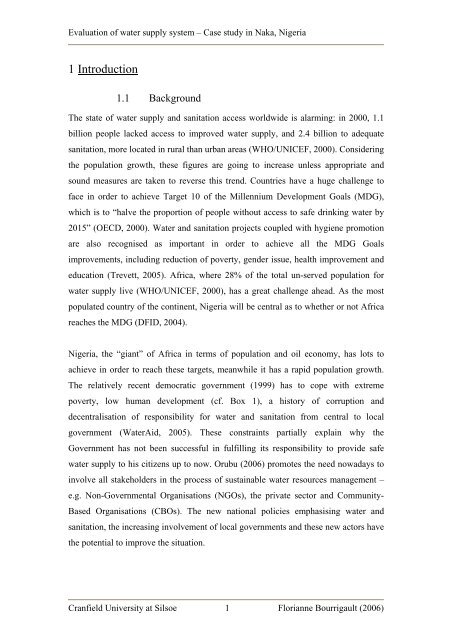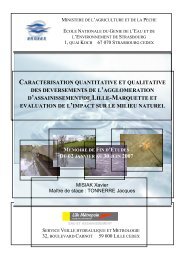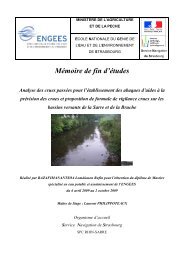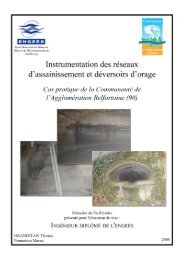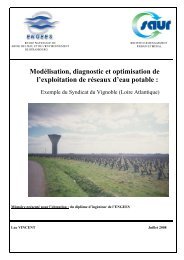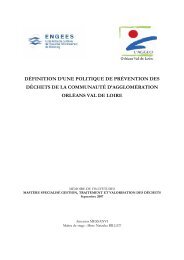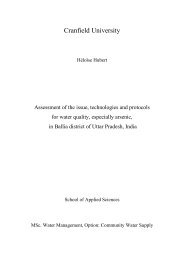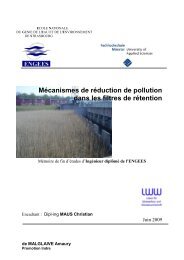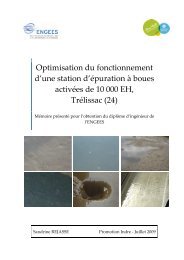Evaluation of water supply system Case study in Naka ... - ENGEES
Evaluation of water supply system Case study in Naka ... - ENGEES
Evaluation of water supply system Case study in Naka ... - ENGEES
- No tags were found...
Create successful ePaper yourself
Turn your PDF publications into a flip-book with our unique Google optimized e-Paper software.
<strong>Evaluation</strong> <strong>of</strong> <strong>water</strong> <strong>supply</strong> <strong>system</strong> – <strong>Case</strong> <strong>study</strong> <strong>in</strong> <strong>Naka</strong>, Nigeria1 Introduction1.1 BackgroundThe state <strong>of</strong> <strong>water</strong> <strong>supply</strong> and sanitation access worldwide is alarm<strong>in</strong>g: <strong>in</strong> 2000, 1.1billion people lacked access to improved <strong>water</strong> <strong>supply</strong>, and 2.4 billion to adequatesanitation, more located <strong>in</strong> rural than urban areas (WHO/UNICEF, 2000). Consider<strong>in</strong>gthe population growth, these figures are go<strong>in</strong>g to <strong>in</strong>crease unless appropriate andsound measures are taken to reverse this trend. Countries have a huge challenge t<strong>of</strong>ace <strong>in</strong> order to achieve Target 10 <strong>of</strong> the Millennium Development Goals (MDG),which is to “halve the proportion <strong>of</strong> people without access to safe dr<strong>in</strong>k<strong>in</strong>g <strong>water</strong> by2015” (OECD, 2000). Water and sanitation projects coupled with hygiene promotionare also recognised as important <strong>in</strong> order to achieve all the MDG Goalsimprovements, <strong>in</strong>clud<strong>in</strong>g reduction <strong>of</strong> poverty, gender issue, health improvement andeducation (Trevett, 2005). Africa, where 28% <strong>of</strong> the total un-served population for<strong>water</strong> <strong>supply</strong> live (WHO/UNICEF, 2000), has a great challenge ahead. As the mostpopulated country <strong>of</strong> the cont<strong>in</strong>ent, Nigeria will be central as to whether or not Africareaches the MDG (DFID, 2004).Nigeria, the “giant” <strong>of</strong> Africa <strong>in</strong> terms <strong>of</strong> population and oil economy, has lots toachieve <strong>in</strong> order to reach these targets, meanwhile it has a rapid population growth.The relatively recent democratic government (1999) has to cope with extremepoverty, low human development (cf. Box 1), a history <strong>of</strong> corruption anddecentralisation <strong>of</strong> responsibility for <strong>water</strong> and sanitation from central to localgovernment (WaterAid, 2005). These constra<strong>in</strong>ts partially expla<strong>in</strong> why theGovernment has not been successful <strong>in</strong> fulfill<strong>in</strong>g its responsibility to provide safe<strong>water</strong> <strong>supply</strong> to his citizens up to now. Orubu (2006) promotes the need nowadays to<strong>in</strong>volve all stakeholders <strong>in</strong> the process <strong>of</strong> susta<strong>in</strong>able <strong>water</strong> resources management –e.g. Non-Governmental Organisations (NGOs), the private sector and Community-Based Organisations (CBOs). The new national policies emphasis<strong>in</strong>g <strong>water</strong> andsanitation, the <strong>in</strong>creas<strong>in</strong>g <strong>in</strong>volvement <strong>of</strong> local governments and these new actors havethe potential to improve the situation.Cranfield University at Silsoe 1 Florianne Bourrigault (2006)


